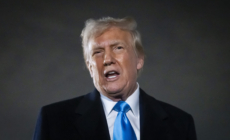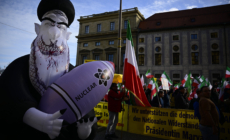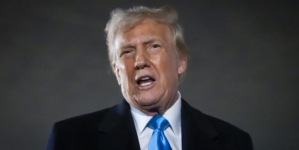-
Woman Unsure How To Handle Coworker’s Life-Changing Personal News: ‘Big Surprise’ - 20 mins ago
-
For China, Trump’s Moves Bring Pain, but Also Potential Gains - 32 mins ago
-
Why Is Crypto Down? Trump Tariffs Spook Markets - 56 mins ago
-
Trade War Heats Up After Trump Orders Tariffs and Canada Retaliates - about 1 hour ago
-
Pictures Show US Combat Jets Training at Strategic Pacific Island - 2 hours ago
-
Crews Move Closer to Recovering All Bodies in D.C. Crash - 2 hours ago
-
Car Bomb Kills at Least 15 in Northern Syria, Dozens Injured - 2 hours ago
-
Drake’s Dad Reacts to Kendrick Lamar’s Grammys Success With ‘Not Like Us’ - 3 hours ago
-
Grammys 2025’s Unforgettable Looks: Bianca Censori, Taylor Swift, Chappell Roan - 3 hours ago
-
No More Talk: It’s Time to Destroy Iran’s Nuclear Weapons Program | Opinion - 3 hours ago
No More Talk: It’s Time to Destroy Iran’s Nuclear Weapons Program | Opinion
It’s a trap.
President Donald Trump loves making deals but there is no deal to be had with Iran on its nuclear program, just dead-end negotiations. Instead, when Israeli Prime Minister Benjamin Netanyahu visits Washington next week, the deal he should make is with Israel, to support, if not join it, in destroying Iran’s nuclear facilities.
Trump certainly knows a good deal from a bad one. He correctly withdrew in 2018 from the 2015 Iran nuclear agreement, which he rightly described as a “disastrous deal.” Trump believed, in his first term, that a good deal with Iran was possible.

TOBIAS SCHWARZ/AFP via Getty Images
That belief appears to continue into his second term. As Marco Rubio told senators at his confirmation hearing for secretary of state, “we should be open to any arrangement that allows us to have safety and stability in the region.”
True, but there is no such arrangement to be had. The circumstances have changed radically since Trump’s first term.
The biggest change that Trump must contend with is that time is entirely on Iran’s side.
When Trump first launched his “maximum pressure” campaign of tough economic sanctions, Iran needed roughly a year to “breakout”—produce enough weapons-grade uranium for a single nuclear bomb. After years of advances, Iran could now reach that milestone in just 10 days. In a month, it could have 10-bombs’ worth of highly enriched uranium.
Another change in Iran’s favor is that one of the most powerful tools for twisting Iran’s arm is expiring soon. One of the rare bright spots of the 2015 agreement is the so-called “snapback” mechanism that allows any party to the deal—including U.S. allies in the United Kingdom and France—to reimpose all previous United Nations sanctions on Iran almost singlehandedly, bypassing the Security Council vetoes that Russia or China would surely exercise to shield their Iranian client. Yet, snapback expires in less than 9 months, on Oct. 18. Realistically, however, given UN timelines for invoking snapback, it would have to be used much earlier than that.
Still, tough sanctions didn’t stop Iran’s pursuit of a bomb before and they certainly won’t now. At some point, Iran will just break out.
Iran is already enthusiastically embracing the potential for new talks. But it’s a ruse. Iran’s negotiators are already hard at work convincing the Europeans of their sincerity, delaying snapback until it has expired. Then their plan is to ensnare Trump in endless talks while their centrifuges spin away, rendering their nuclear ambitions a fait accompli.
But there have also been positive changes since Trump was last in the White House that make preventing a nuclear Iran much more feasible than perhaps any time before.
Iran’s nuclear program now lies exposed and effectively unprotected thanks to Israel crushing Hamas, degrading Hezbollah and its rocket arsenal, demolishing Syria’s heavy weaponry, and wrecking Iran’s most capable air defense systems. Meanwhile, Israel’s defenses have held strong against repeated Iranian missile attacks, bolstered by American anti-missile batteries.
Thus, previous concerns that might have weighed against military action no longer apply. Iran’s airspace is relatively uncontested, enabling repeated strikes against its nuclear facilities with relative impunity. Tehran’s ability to retaliate is significantly diminished—though it should never be discounted. Further, Israel’s attacks on the Iranian axis have given the lie to fears of triggering regional war or “World War III.”
Yet here, too, the clock is ticking. Iran is expected to complete this year a new nuclear facility, buried so deeply under a mountain that even the most powerful American bunker buster might not be able to reach it. Meanwhile, Iran and Russia just signed a new Comprehensive Strategic Partnership, which could see Moscow help Iran rebuild its air defenses.
In other words, the time to act to prevent a nuclear Iran is in the coming months.
So, the deal to cut is with Israel, to strike Iran’s nuclear facilities. That means at least providing Israel what it needs, such as bombs, precision-guided weapons, and KC-46 aerial refueling tankers, while deterring Iran from any major retaliation. Best would be for the U.S. to also collaborate, bringing to bear its special capabilities to hit the deeply buried facilities and multiple nuclear-related installations spread across Iran.
And if Tehran tries to rebuild, then Israel and the U.S. will have to go back in, until a new regime arises in Tehran that focuses on the welfare of its people instead of domestic, regional and global terror and hegemony.
That is the agreement that Trump and Netanyahu should aim for—a U.S.-Israel accord that, as Rubio put it, “allows us to have safety and stability in the region.”
Michael Makovsky, a former Pentagon official, is the President and CEO of Jewish Institute for National Security of America. John Hannah is the Wax Senior Fellow at JINSA, and former national security advisor to Vice President Dick Cheney.
The views expressed in this article are the writers’ own.
Source link


















